
Norwich is a city in New London County, Connecticut, United States. The Yantic, Shetucket, and Quinebaug Rivers flow into the city and form its harbor, from which the Thames River flows south to Long Island Sound. The city is part of the Southeastern Connecticut Planning Region. The population was 40,125 at the 2020 United States Census.

The John Rider House is located on Main Street in Danbury, Connecticut, United States. It is a wooden frame house dating to the late 18th century.
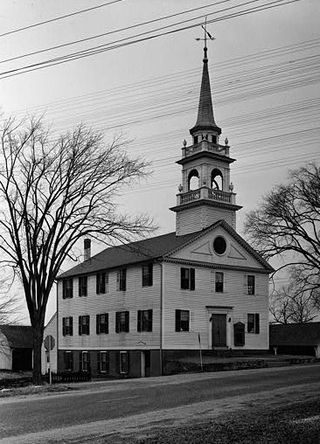
Preston City is a village and the original town center of the town of Preston, Connecticut. The core of the village around the junction of Old Northwest Road and Route 164 is designated as the Preston City Historic District, a historic district that is listed on the National Register of Historic Places. The district is located along Old Shetucket and Amos Roads, which, prior to the 1930s, were major thoroughfares.

The Harrison House, also known as Harrison–Linsley House and incorrectly as the Swain-Harrison House, is a historic house museum at 124 Main Street in Branford, Connecticut. Built in 1724 by a descendant of Branford's founders, it is a good example of a Connecticut saltbox structure. The house was listed on the National Register of Historic Places in 1975, and is a contributing property to the Canoe Brook Historic District. Since 2016 it has been operated as a house museum by the Branford Historical Society.
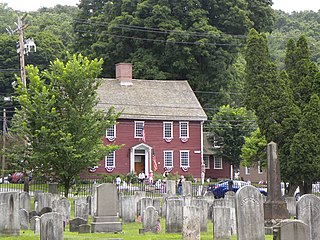
The General David Humphreys House is a historic house museum at 37 Elm Street in Ansonia, Connecticut. Built in the 1690s, it was the birthplace of the American Revolutionary War Colonel David Humphreys. It is now owned by the Derby Historical Society and serves as its headquarters. The house was listed on the National Register of Historic Places in 1972.
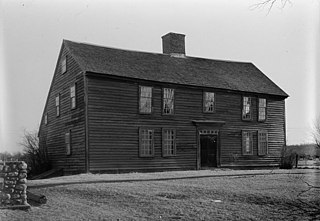
The Thomas Lee House is a historic house at the junction of Giant's Neck Road and Connecticut Route 156 in the Niantic section of East Lyme, Connecticut, United States. Built about 1660, it is one of the oldest wood-frame houses in Connecticut. Restored in the early 20th century by Norman Isham, it is now maintained by the East Lyme Historical Society as a museum. It was listed on the National Register of Historic Places in 1970.
The Last Green Valley National Heritage Corridor is a federally designated National Heritage Corridor in northeastern Connecticut and portions of Massachusetts. It has a rural character with rolling hills, farmland and classic New England scenery. This area was designated because it is one of the last remaining stretches of green in the Boston to Washington, D.C. heavily urbanized corridor. The valley also has the largest stretch of dark night sky in the Northeast megalopolis corridor. It contains some of the largest unbroken forests in Southern New England, in a region of Connecticut known as the Quiet Corner.

Norwichtown is a historic neighborhood in the city of Norwich, Connecticut. It is generally the area immediately north of the Yantic River between I-395 and Route 169.

The Carpenter House, also known as the Gardiner (Gardner) Carpenter House and the Red House, is a Georgian style house in Norwichtown area of Norwich, Connecticut. A house was previously on the site, but it was removed by Gardner Carpenter to construct the house in 1793. The three-story Flemish bond Georgian house's front facade consists of five bays with a gabled porch over the main entrance and supported by round columns. The gambrel roof and third story addition were added around 1816 by Joseph Huntington. In 1958, a modern one-story rear wing was added to the back of the house. The interior of the house is a center hall plan with 10-foot (3.0 m) high ceilings and has been renovated, but retains much of its original molding, paneling and wrought iron hardware. It was listed on the National Register of Historic Places in 1970 and added to the Norwichtown Historic District in 1973.
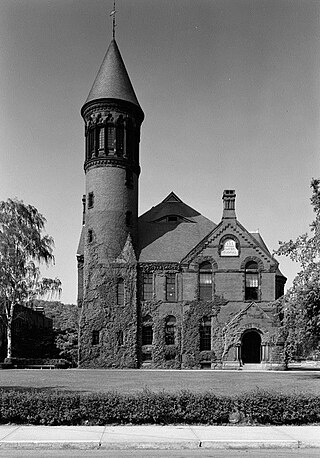
The Chelsea Parade Historic District encompasses a predominantly residential area north of downtown Norwich. Centered around the Chelsea Parade, a triangular public park, the area has long been a preferred residential area for the city's upper classes, and includes a catalog of architecture from the 18th to 20th centuries. It includes 565 contributing buildings, two other contributing sites, and six contributing objects over an area of 205 acres (83 ha). The district was listed on the National Register of Historic Places in 1989.

The Nathaniel Backus House is a two-story Greek Revival clapboarded house with a gable roof in Norwich, Connecticut. The house was built around 1750 by Nathaniel Backus and served as his home, it was later moved to its current location in 1952. The house originally began as a Colonial, but was greatly modified to Greek Revival around 1825, reconfiguring the central door to the left of the facade and adding two chimneys. The house is a historic house museum operated by the Faith Trumbull Chapter of the Daughters of the American Revolution.
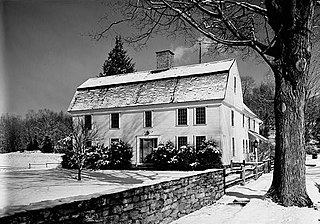
The Bradford-Huntington House is a historic house at 16 Huntington Lane in the Norwichtown section of Norwich, Connecticut, United States. The house was built in stages, beginning around 1691, and is one of the oldest to survive in the area. It was owned by American Revolutionary War officer Jabez Huntington. It is claimed that Huntington hosted George Washington here. The house was listed on the National Register of Historic Places in 1970. It is also a contributing property in the Norwichtown Historic District.

The Joseph Carpenter Silversmith Shop is a historic building that was built between 1772 and 1774 on the green in Norwichtown, now a section of Norwich, Connecticut. It is a 30 feet (9.1 m) by 24 feet (7.3 m) 1+1⁄2-story clapboarded building with a gambrel roof. The interior has a single brick chimney that was used for the forge, but it has been modified and adapted for modern use with modern doors, electric lighting and heat, and a disappearing overhead stairway that leads to the attic. Joseph Carpenter (1747–1804) was a successful of silversmith, clockmaker, and pewterer, and shared the building with his brother, a merchant. The shop was added to the National Register of Historic Places on October 6, 1970, and was listed as a contributory property for the Norwichtown Historic District on January 17, 1973.
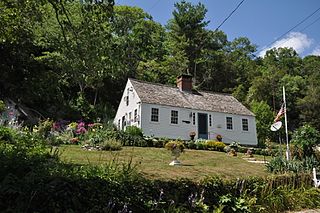
The Capt. Richard Charlton House is a historic house at 12 Mediterranean Lane in Norwich, Connecticut. Built about 1800, it is a well-preserved example of an early 19th-century cottage with vernacular style. The house was listed on the National Register of Historic Places in 1970.
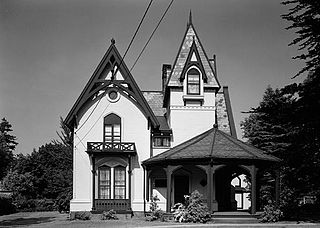
The Converse House and Barn are a historic residential property at 185 Washington Street in Norwich, Connecticut. Built about 1870 for a local businessman and philanthropist, it is a prominent local example of High Victorian Gothic architecture. The property was listed on the National Register of Historic Places in 1970, and is included in the Chelsea Parade Historic District.
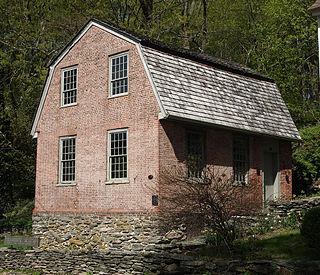
The East District School is a historic school building at 365 Washington Street in Norwich, Connecticut. Built in 1798, it is significant as a rare and well-preserved 18th-century schoolhouse, and as the location of an evening school for adults established by Consider Sterry, author of an early guide to practical navigation. The school was listed on the National Register of Historic Places in 1970, and is a contributing property to the Norwichtown Historic District.

The Dr. Daniel Lathrop School is a historic school building at 69 East Town Street in the Norwichtown section of Norwich, Connecticut. It is a single-story brick structure with a gambrel roof, located facing the village green next to the Joseph Carpenter Silversmith Shop, another historic building. Built in 1782, it is one of the oldest surviving brick school buildings in the state. The building was listed on the National Register of Historic Places on December 29, 1970. It now serves as a visitors center for the local historical society.

The Gov. Samuel Huntington House is a historic house at 34 East Town Street in Norwich, Connecticut. The house was built in 1783 by Samuel Huntington (1731–96), a signer of the United States Declaration of Independence and a Governor of Connecticut. It was listed on the National Register of Historic Places on October 6, 1970, and is a contributing property to the Norwichtown Historic District.

The Dr. Philip Turner House is a historic house at 29 West Town Street in Norwich, Connecticut. Possibly built in the late 17th century, it is one of the oldest houses in Norwich, and well-preserved example of vernacular architecture. At the time of the American Revolutionary War it was probably owned by Dr. Philip Turner, a leading surgeon for the Continental Army. It was listed on the National Register of Historic Places on October 15, 1970.

The Dr. Joshua Lathrop House is a historic house at 377 Washington Street in Norwich, Connecticut. Built about 1750, it is an example of Georgian residential architecture of that period and further notable as the home of the first pharmacist in the state, who operated out of these premises. The house was listed on the National Register of Historic Places on December 29, 1970, and is a contributing property to the Norwichtown Historic District.






















